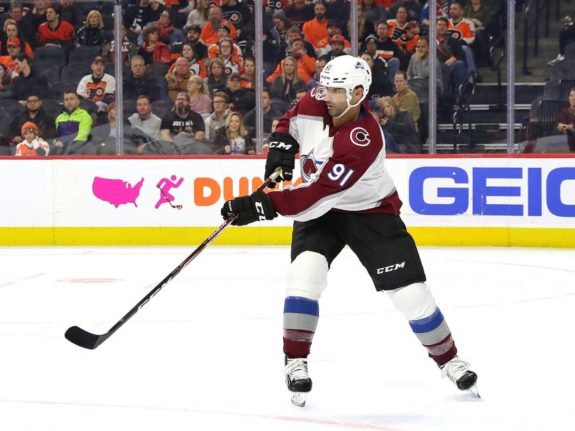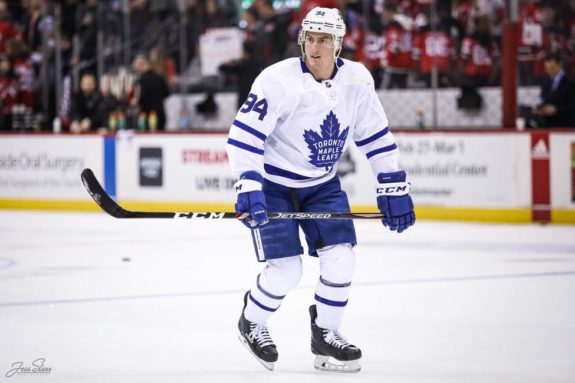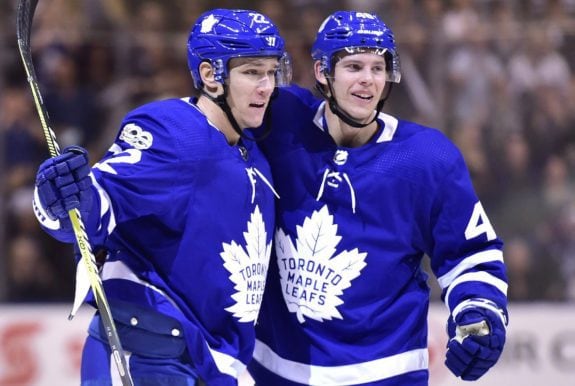A little over a year ago, the Colorado Avalanche completed a blockbuster deal with the Toronto Maple Leafs.
On July 1st, 2019, the Avs traded defenseman Tyson Barrie, forward Alex Kerfoot, and a 2020 sixth-round pick to the Maple Leafs in exchange for forward Nazem Kadri, defenseman Calle Rosen, and a 2020 third-round pick. At the time, Kerfoot was a pending RFA, and Barrie had one year left on his contract. Meanwhile, Kadri was entering the fifth year of a six-year contract.
The Big Guns
We’ll talk about the centrepieces of the trade to start. At the time, I thought the trade looked like it benefitted the Leafs more than anything. Kadri was coming off of a down year in which he put up 44 points in 73 games, and he was developing a bit of a reputation for not being able to keep his emotions in check during crunch time. The league suspended him for three games for boarding forward Tommy Wingels in game one of the Maple Leafs’ 2018 series against the Boston Bruins.
The following year, the NHL suspended Kadri for the rest of the first round after cross-checking Bruins’ forward Jake DeBrusk. The Leafs would go on to lose both series, and losing a player of Kadri’s calibre two years in a row certainly didn’t help. And with the addition of John Tavares the year before, it really didn’t make sense to pay him 4.5 million to play on the third line.

Meanwhile, the Leafs were acquiring Barrie, addressing one of their biggest needs in a top-four, right-handed defenseman. The same was true of Kerfoot, who was four years younger than Kadri and had similar success in the 2018-19 campaign — he finished with 42 points through 78 games. The Leafs seemed to kill two birds with one stone for this move, but at the same time, it’s easy to see why Sakic pulled off the deal.
Given the fact that Cale Makar was going to make the team that year and that Barrie was likely to demand upwards of six or seven million on the open market, keeping him didn’t make sense. While the loss of Kerfoot may have hurt, he made a gamble on Kadri returning to his 32-goal form he had in his previous two seasons. The Leafs were making moves to make a cup run specifically that year, and the Avs were opening up some future cap room while upgrading their second-line centre.
For the Leafs, the results from their acquisitions were disappointing, to say the least. Barrie suffered the worst start to a season dating back to his rookie year in the NHL. But in his defense, he was horribly misused by then-head coach Mike Babcock. He demoted Barrie to the second powerplay unit, and he saw limited minutes in comparison to his time with the Avs.

In 23 games under Babcock, Barrie registered only five assists and not a single goal. Then, after Sheldon Keefe took over, he found his game again and finished off the season with 34 points in the final 47 games of the season. Granted, things slowed down a little bit towards the last few games before the COVID shutdown, and he was more or less invisible during the qualifying round against Columbus, with zero points through five games.
Kerfoot, on the other hand, suffered a bit of a down year himself. After posting back-to-back 43 and 42 point seasons, he finished the 2019-20 campaign with 28 points in 65 games. With injuries to top-six forwards like Ilya Mikheyev and Andreas Johnsson, Kerfoot often found himself on the wing alongside John Tavares instead his expected third-line centre role. I found that Kerfoot looked more comfortable in the games when he played centre instead of wing, so that may have contributed to his down year. Regardless, they weren’t the results he or the Leafs were hoping for.
Taking a look at Kadri’s first season with the Avs, it certainly seems Sakic’s gamble paid off. The London, Ontario native seemed much more comfortable in the second-line centre role he’s used to and had a great season, where he finished with 36 points through 51 games. He missed a chunk of time towards the end of the season, but throughout a full 82 games, he would’ve been on pace for 58 points.
He also turned into an animal come playoff time, emerging into a pivotal member of the Avs’ offense, with 18 points through 15 games, including a buzzer-beater in game one of the round-robin against the St. Louis Blues.
Kadri seemed to mature as a player in his first season with the Avalanche and shedding the suspension act certainly proved to help the team out over the course of the playoffs. His goal scoring touch, combined with his gritty style of play, is something no head coach would complain about on his second line.
Taking a look at where the centerpieces are now, Kadri is obviously still with the Avalanche. And at this point, you’d have to believe they would look at re-signing him if they can afford him. Kerfoot is entering the second year of a three-year contract with the Leafs, at an AAV of $3.5 million. Meanwhile, Barrie inked a one-year contract with the Edmonton Oilers worth $3.75 million. That’s far less than what I predicted he would get when the trade originally happened. But then again, that’s what a down year will do.
The Icing on the Cake
I’m going to throw Calle Rosen into the category of draft picks/lesser-known pieces simply because he didn’t really make an impact for either team. And I say either team because Rosen only spent half a season with the Avs organization before they traded him back to Toronto in exchange for goaltender Michael Hutchinson.
Rosen appeared in eight games for the Avs in which he had two points, but he spent the majority of his time with the Colorado Eagles. Hutchinson was struggling as the Maple Leafs’ backup, which led to them trading him in the wake of the Jack Campbell acquisition from the L.A. Kings. Hutchinson, meanwhile, stepped up for the Avalanche when both Philipp Grubauer and Pavel Francouz went down with injury.

In terms of the draft picks, this could also prove the Avalanche as the winners of this trade. The Avs used their third-round pick to select Jean-Luc Foudy, a speedy centre who’s draft rankings projected him to go in the second round. The Leafs, meanwhile, used the sixth-round pick obtained in the trade to select centre Joe Miller. They drafted right out of high school, and as of now, there’s no way to predict what he’ll turn into as an NHLer.
FULL TRADE AFTER PICKS
TO TOR
D Tyson Barrie (Now with EDM)
F Alex Kerfoot
F Joe Miller
TO COL
F Nazem Kadri
D Calle Rosen (Now with TOR)
F Jean-Luc Foudy
Who Won the Trade?
As of now, I think the Avalanche remain the winners of this trade. It’s hard to predict who the long-term winners will be simply because we don’t know what Foudy and Miller will turn into (although the former has a much better chance of making an impact than the latter). It also depends on if Kerfoot can turn his game around next season. But after one year, the Avs got Kadri back to his previous form, and he was an integral part of their playoff run, while Barrie and Kerfoot both suffered down years, and the Leafs didn’t make it past the qualifying round.
Again, it’s one of those trades you’ll have to look back on again in a few years. You can’t really rip Kyle Dubas for it, given what the Leafs expected Barrie and Kerfoot to bring to the team. That said, missing the playoffs and losing Barrie after one year wasn’t a good look. It will be interesting to see how each draft pick pans out for their team and how Kadri and Kerfoot will utilize the second year with their new teams.